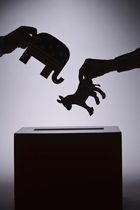Final Look at Election Demographics
Posted On November 6, 2012
 Almost exactly one year ago, Pew took a generational look at the coming election and found a distinct generation gap: the preferences of the youngest and the oldest groups of voters were distinctly at odds. A year and billions of dollars of campaigning has altered that basic equation only slightly.
Almost exactly one year ago, Pew took a generational look at the coming election and found a distinct generation gap: the preferences of the youngest and the oldest groups of voters were distinctly at odds. A year and billions of dollars of campaigning has altered that basic equation only slightly.
Pew’s final look at the demographics of the 2012 election reflects essentially the same gap as its first. In October 2011, Millennials favored the Democratic candidate by a margin of 26 points. Today that margin is 21. A year ago Matures preferred the Republican candidate by a margin of 10. Today that margin is 19. As it stands, the generation gap in politics is as statistically large as any since 1972 – around the time the term “generation gap” first came into vogue. Preferences among Boomers and Gen Xers have remained either even or very close.
The persistence of these preferences suggests that there is a very real generational dynamic at work. A peek at the demographics inside the demographics explains that to some degree. Millennials are the most ethnically diverse generation. When Pew breaks each generation down into its racial and ethnic components, it becomes clear that the diverse makeup of the Millennial generation may be partially responsible for its polling preferences. Likewise, the Matures are the least diverse generation. The gap, then, may be demographic as much as it is culture or age-related.
http://www.people-press.org/2012/10/29/presidential-race-dead-even-romney-maintains-turnout-edge/2/
http://www.people-press.org/2011/11/03/the-generation-gap-and-the-2012-election-3/